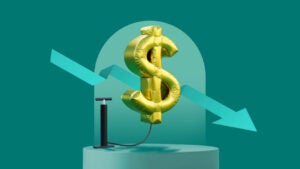The ‘Barbie’ movie’s big money lesson: 3 lesser-known ways to grow your savings

Anything is possible. That’s definitely been the case with this summer’s blockbuster “Barbie” movie, which has so far topped over $1 billion in worldwide box office sales. But despite those impressive financials, there’s a moment in the film where Barbie’s character brings up a matter that likely resonates with many consumers when it comes to money: She says she doesn’t know what a certificate of deposit (CD) is.
In one scene, Barbie says, “I just have all my money in a savings account.” Ken responds, “That’s totally wrong. You need treasury bonds, corporate bonds, CDs… CD stands for certificate of deposit.”
While the exchange is light-hearted, there’s some truth to Ken’s statement. Treasury bonds, corporate bonds and CDs are all types of investments that could earn you much more than if you simply keep your money in a traditional savings account.
These lesser-known financial instruments each have their own perks and potential drawbacks, so some may be better fitted to you than others. If you find yourself in the same boat as Barbie, here’s what you should know about CDs, treasuries and corporate bonds, so that you’re one step ahead of Ken and getting the most out of your savings.
1. CDs
CDs aren’t just for music, as Barbie learns. They’re also a type of financial product, standing for a certificate of deposit, that allows you to keep a certain amount of money in the bank for a set period of time. That amount of time is known as the CD’s term, and terms can range from a few months to several years.
The bank rewards you for locking away your money by paying a guaranteed annual percentage yield (APY) that’s fixed throughout the term. Often, that APY can be higher than what you’d earn on a savings account.
For example, suppose you invested $5,000 in a one-year CD with an APY of 5.25 percent. At the end of one year, you’d earn $262.50 in interest, for a total ending amount of $5,262.50.
That’s assuming you don’t withdraw any funds early, however. Most CDs charge an early withdrawal penalty for taking out any of the balance before the CD matures, which could result in losing some or all of the interest earned. Some banks offer no-penalty CDs, though, which allow you to withdraw funds early with no fee, albeit potentially at a lower APY.
CDs are a great fit for saving when it comes to short- and medium-term goals. You can choose a term that best aligns with your goal. If you’re saving to buy a car in about two years, for example, you could open a two-year CD.
They can also serve as a counterbalance for stock market investors during volatile times. As the stock market fluctuates, the rate of return on a CD is guaranteed and can provide some stability to a portfolio. You’ll know exactly how much will be earned by the end of the CD’s term.
Who they’re best for:
- Those looking for a safe haven to grow their funds, without the higher risks associated with other investment types.
- Those who are certain they won’t need access to the deposited funds for the duration of the term.
2. Treasury bonds
Treasury bonds, sometimes referred to as “T-bonds” or “treasuries,” are essentially loans that consumers give to the U.S. government. In return, the government pays you interest for the duration of the bond and returns your principal (plus earnings) when the bond matures. The government issues these bonds to finance infrastructure projects, social programs or simply day-to-day operations.
Treasuries typically have longer maturity durations, either 20 or 30 years. They pay interest every six months until maturity. Unlike CDs, treasuries aren’t issued by banks — you buy them directly from the U.S. Treasury via its online platform, TreasuryDirect. Alternatively, they can be bought on the secondary market from banks or brokers.
Because they’re backed by the full faith and credit of the U.S. government, treasuries are one of the safest investment types. They’re often used as a benchmark to determine the creditworthiness of other investments.
Who they’re best for:
- Investors looking for a low-risk and stable addition to their portfolio.
- Retirees or individuals seeking a passive income stream, as these bonds pay periodic interest.
3. Corporate bonds
Corporate bonds resemble personal loans, but in this case, you’re the lender and the corporation is the borrower. As with Treasury bonds, you receive periodic interest payments (called coupon rates) on the initial amount you lent, until the bond matures or reaches its due date. In this case, interest is paid by companies rather than the government.
You could potentially earn more on corporate bonds than treasuries or CDs, albeit at a somewhat higher risk. The company could default on its payments. This risk is reflected in the bond’s credit rating, so it’s wise to check its rating offered by agencies like Moody’s and S&P Global. Still, corporate bonds are less volatile and less risky than stocks.
Like Treasuries, corporate bonds can be bought and sold on the secondary market through brokers, giving them some liquidity that’s not offered by CDs. However, since bond prices can fluctuate, there’s no guarantee that you’ll receive all your money back if you sell one.
Who they’re best for:
- Investors who are comfortable taking on slightly more risk compared to CDs and treasuries but expect better returns.
- Those who want to diversify their investment portfolio with varying risk levels.
CDs, treasuries and corporate bonds compared
It’s important to compare the risks and benefits of each of these investments before putting your money into one. Here is how they differ across various features:
| CDs | Treasury bonds | Corporate bonds | |
|---|---|---|---|
| Issued by | Banks and credit unions | The U.S. government | Companies |
| Return on investment | Fixed yield for the duration of the term, typically higher than savings accounts but lower than corporate bonds | Modest yields, but pay a guaranteed rate every six months | Higher earning potential, but the return correlates with the company’s health and market conditions |
| Risk | Low risk | Low risk | Moderate risk, depending on the issuing company’s creditworthiness |
| Liquidity | Funds are typically inaccessible until the CD matures, after a few months or several years | Can be sold on the secondary market before maturity, and pay out interest every six months | Can be sold on the secondary market before maturity, and typically pay out interest every six months |
| Taxes | Interest earned is subject to state and federal taxes | Exempt from state and local taxes but subject to federal tax | Subject to federal, state and local taxes |
| Best for | Short- to medium-term goals | Long-term goals | Depends on the individual bond’s term |
Bottom line
Taking a note from the “Barbie” movie, exploring the diverse world of saving and investing can lead to better returns and diversified portfolios.
Whether you’re drawn to the guaranteed earnings of CDs, the reliability of treasury bonds or dynamic corporate bonds, make sure to assess the risks and benefits of each.
It’s also important to consider any minimum deposit requirements, how interest rates compare to top rates available elsewhere and how long you can afford to lock your money away for. Doing your research should pay off and help make you feel more confident in your financial decisions.






